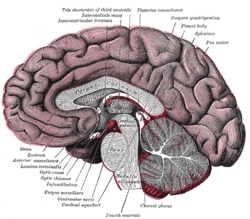Posterior commissure
| Posterior commissure | |
|---|---|
 Sagittal cross-section of the human brain. The posterior commissure is labelled at center top. | |
|
The posterior commissure labelled on a human brain | |
| Details | |
| Part of | Human brain |
| Identifiers | |
| Latin | commissura posterior |
| NeuroNames | 484 |
| NeuroLex ID | birnlex_1026 |
| TA | A14.1.08.416 |
| FMA | 62072 |
| Anatomical terms of neuroanatomy | |
The posterior commissure (also known as the epithalamic commissure) is a rounded band of white fibers crossing the middle line on the dorsal aspect of the rostral end of the cerebral aqueduct. It is important in the bilateral pupillary light reflex.
Its fibers acquire their medullary sheaths early, but their connections have not been definitively determined. Most of them have their origin in a nucleus, the nucleus of the posterior commissure (nucleus of Darkschewitsch), which lies in the periaqueductal grey at rostral end of the cerebral aqueduct, in front of the oculomotor nucleus. Some are thought to probably bederived from the posterior part of the thalamus and from the superior colliculus, whereas others are believed to be continued downward into the medial longitudinal fasciculus.
The posterior commissure interconnects the pretectal nuclei, mediating the consensual pupillary light reflex.
References
This article incorporates text in the public domain from page 812 of the 20th edition of Gray's Anatomy (1918)
External links
| Wikimedia Commons has media related to Posterior commissure. |